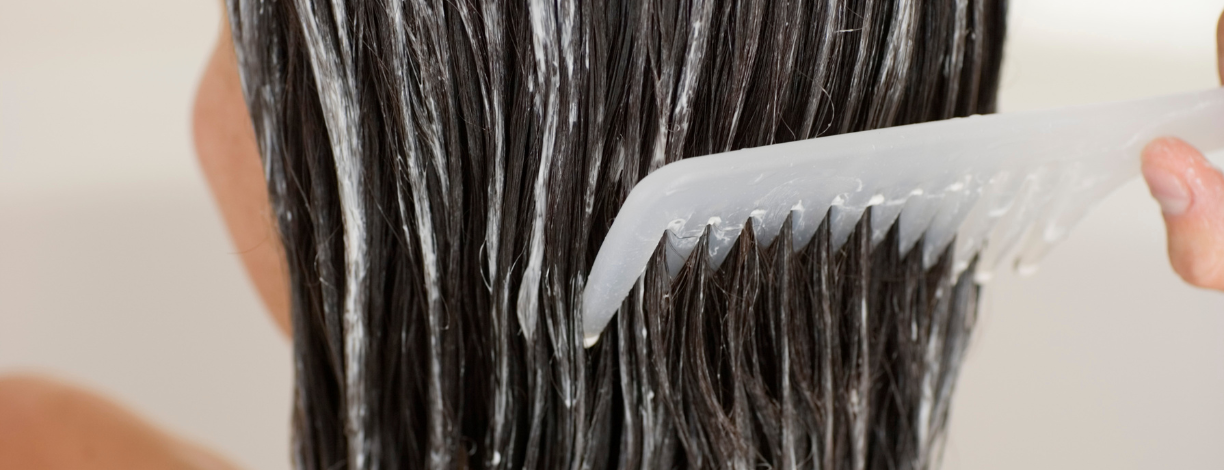Our Blog
Damage-Free Detangling
(Spoiler Alert: It’s a Mindset, not a Method) Whether your hair is curly or straight, tangles are just a part of life. Removing them can sometimes feel like a scene from Mission Impossible! We’re here to tell you that if you do it right, it shouldn’t feel that intense, difficult, or, well, impossible. If all of your detangling efforts happen on wash day, you’re doing it wrong. Here’s how to cultivate a tangle-minimization mindset so that you can spend your wash day pampering and not torturing your hair. PART I – PREVENTION Get Regular Trims This won’t make your hair grow faster, but it will help minimize tangles by reducing split ends and ‘orphan’ hairs that are shorter than surrounding hair strands. These areas of breakage cause friction that breed ‘fairy knots’ – extremely tiny tangles that are very difficult to remove without cutting. Call the Original Moxie Salon at 734-340-4022 to book your next trim. Detox, Detox, Detox Mineral build-up on the hair is one of the main culprits when it comes to tangling. Hard water and chlorine deposit microscopic particles onto the hair that dry and roughen the hair. Again, anything that increases friction on the surface of the hair will lead to tangling. To combat hard water, you must use a chelating shampoo or treatment that contains specific ingredients that bind with and remove minerals from the hair. If your exposure is frequent, we recommend a chelating shampoo such as Triple Threat combined with Professional Moisture Detox Treatments. If it’s gradual and/or seasonal, you can get by with seasonal Moisture Detoxes. Use our store finder to find a Moisture Detox provider near you! Wear That Bonnet! When we lay our heads down to sleep, and then roll around, sweat, drool, etc, it’s like Tangle-palooza for your hair strands. To prevent tangles at night, we strongly recommend that you wear a satin bonnet or, at the very least, use a satin pillowcase. Beware The Necklace! Sad, but true. That cute chain on your neck can be death to the delicate hairs at your nape. The tiny mechanics of a metal clasp are just right for snatching and slashing any hairs that are unfortunate enough to come their way. What can you do? Try this clever hack from Cosmopolitan that uses an aquarium tube to protect your hair from snags. Beware The Rubberband! Rubberbands (yes, even the kind that says non-snag) will cause breakage and breakage causes what? That’s right. Tangles. Instead, use a satin scrunchie or puff cuff to put your hair up PART II – REMOVAL All of these steps will reduce, but not totally eliminate tangles, and that’s half the battle. But despite your best efforts, tangles will show themselves, particularly in tightly coiled hair. The coiled structure of the hair means that shed hairs almost knot themselves onto the remaining hairs of the same curl family. Here are some simple tips for damage-free detangling: To remove the ones that crop up, we recommend a gentle, progressive process that starts with your shampoo. Get Clean No-Foam Shampoo is cream-based and slippery, allowing you to soften and loosen tangles with your fingers before you even begin your styling routine. Next, SATURATE your hair with water and conditioner so that your hair literally squishes when you squeeze it (you can see and hear what that’s like in this video). Once your hair is thoroughly saturated with conditioner, continue the detangling process by pulling your fingers through your hair in small sections, working from roots to tips. Do not avoid the roots! We see waaaay too many heads that are detangled only from the first inch down. This can lead to severe matting at the scalp. These are incredibly time-consuming to remove and can lead to serious breakage and loss of length. Really get in there so that your fingers come into contact with your scalp on each pass. If you find that a detangling brush works better for you at this stage, by all means, go for it. Just remember to use one that does not snap or pull your hair. After rinsing out your conditioner, broadcast your moisturizer or all-in-one while still in the shower. For very thick and tightly-curled hair, you can loosely braid your hair in four to six large sections to keep tangles from reasserting themselves. Then pop a shower cap on your head to keep all the hydration in place. If the previous steps have taken care of all your tangles, congratulations! You are done and ready to move on with the rest of your styling. For those with more tangle-prone hair, you may need to finish up with a comb or brush. There are many great detangling brush and comb options out there and they work differently on different hair types. Experiment until you find one that works for you. No matter what tool you use, always start from the bottom and work your way up so that you do not further tighten existing knots. With a prevention mindset and a ‘progress’ approach, you can get your detangling done in under 15 minutes, making this one mission very much accomplished!
Seal in Moisture & Combat Frizz
What's a Sealer? An oil or water-based styling product that smooths the hair shaft and creates a smooth, pliable, protective barrier around the hair. We consider this an optional step for most hair types. Sealers are the final step in your product application, going on after all other styling products have been applied. Sealers: are primarily surface-acting help to combat frizz add shine seal in moisture In general, Sealers are lighter and more malleable than Definers and, because they tend to be oil-based, can provide a soft, pliable finish and no hard cast. For some hair types, this is preferable to the rigid feel of a traditional gel and may offer the same level of frizz control and moisture retention. Take our Hair Type Quiz to learn about your hair type and find the sealer(s) we recommend for you.

Sorry, We couldn't find any results.


